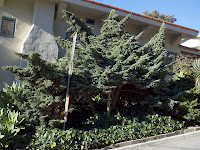We are often approached by homeowners with the question of acceptable landscape plants in the high fire hazard area. While our webiste has a comprehensive list of recommended plants (avalible here), there are also a number of specific plants that are NOT recommeded. Below is an excerpt from the City Fire Departments High Fire Hazard Area Landscape Requirements (Ordinance #5439). The full print out can be found through the City's website or by clicking this link.
_______________________________________________________________________________
Certain plants are considered to be undesirable in the landscape due to characteristics that make them highly flammable. These characteristics can be either physical or chemical. Physical properties would include large amounts of dead material retained within the plant, rough or peeling bark, and the production of profuse amounts of litter. Chemical properties include the presence of volatile substances such as oils, resins, wax, and pitch. Certain native plants are notorious as species containing these volatile substances.
Plants with these characteristics should not be planted in High Fire Hazard areas. They are referred to as target species since their partial or complete removal is a critical part of hazard reduction. The following is a list of plants that are not allowed to be planted within the landscape zones defined below:
Unacceptable Plant Species:
Acacia species
Adenostoma fasciculatum –
Chamise
Adenostoma sparsifolium –
Red Shank
Artemesia californica –
California Sagebrush
Baccharis species (low growing form OK)
Casuarina species -
Beefwood
Cortadera species –
Pampas Grass
Cupressus species –
Cypress
Eriogonum faciculatum –
Common Buckwheat
Eucalyptus species –
Eucalyptus
Juniperous species –
Juniper (except species which grow less than 1ft)
Olneya tesota -
Iron wood
Pennisetum -
Fountain Grass
Pinus species –
Pine
Other plants may be considered undesirable because of their ability to naturalize and become a pest. These types of plants should be avoided, especially in sensitive riparian or coastal areas where they could become established and compete with native vegetation.

